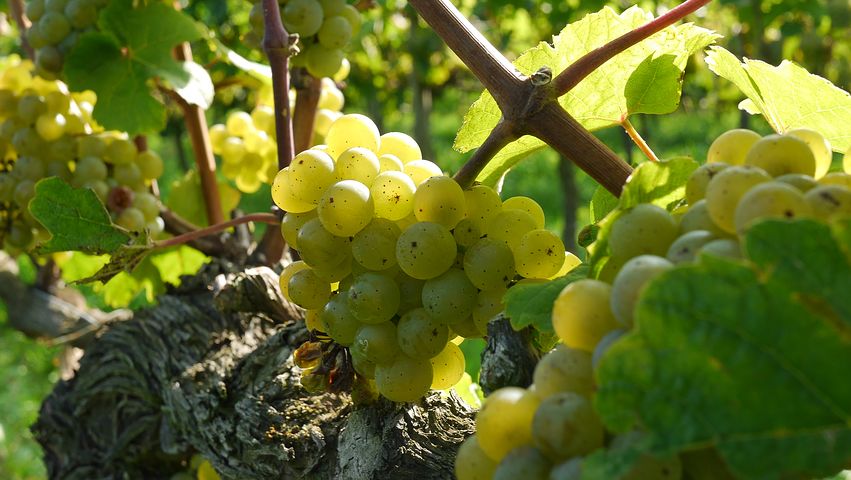The BC chapter of the Canadian Association of Professional Sommeliers, or CAPS recently hosted a seminar titled, “Terroir of Rheingau: The Region of Riesling”, and featured four wines from the prestigious Weingut Robert Weil. ‘Weingut’ can be translated as vineyard, wine growing estate or winery. Export Manager Nicolas Pfaff was on hand to lead us through the tasting and explain what makes the Rheingau region so unique as a producer of riesling.
The BC chapter of the Canadian Association of Professional Sommeliers, or CAPS recently hosted a seminar titled, “Terroir of Rheingau: The Region of Riesling”, and featured four wines from the prestigious Weingut Robert Weil. ‘Weingut’ can be translated as vineyard, wine growing estate or winery. Export Manager Nicolas Pfaff was on hand to lead us through the tasting and explain what makes the Rheingau region so unique as a producer of riesling.
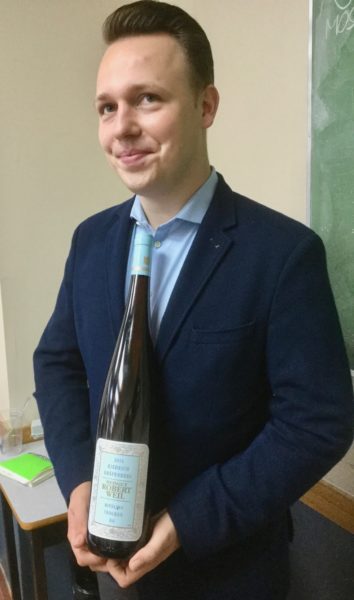
The Rheingau has enjoyed a reputation as being a prime region for top quality rieslings since the mid 1200s. The Rheingau has lots of varying aspects and soil types with varying slate content, all of which contribute to a wine’s flavour profile. Lower vineyards are often covered in fog at harvest time, while those further up the slope are bathed in sunshine.
The range of styles found in the Rheingau relates directly to the three types of vineyards there: those that lie close to the Rhine, those on the middle plateau and those on the hills of the Taunus Hills, which rise to as high as 240m. These high altitude vineyards help create the bright and refreshing wines that are the signature of Weingut Robert Weil.
The winery, which dates back to 1875, is located in the village of Kiedrich. Dr. Weil, with his focus on quality, was soon producing wines that garnered a lot of attention and he was quickly known internationally, especially among the nobility.
Weingut Robert Weil owns three steep hillside sites – Kiedricher Klosterberg, Kiedricher Turmberg and Kiedricher Gräfenberg – each with very different terriors that are reflected in the distinctive flavour profiles of their wines. All face southwest, which gives them excellent exposure to the sun and is so important to ensure ripe grapes. The steepest parts are 60° and are very tricky to navigate given the stony soils. The slate holds the heat of the day and reflects it back on the vines in the evening. All these conditions mean that grapes are often left on the vine to ripen well into November. Environmentally sound vineyard practices are employed at all three sites.
The grapes are harvested by hand, requiring up to seventeen passes through the vineyard for individual cluster selection. This attention to detail in the vineyard is carried on into the cellar. Full-bodied dry wines are fermented and aged in large casks because micro-oxidation provides the wines with greater structural complexity. The light fruitier and sweeter wines only spent time in steel tanks to keep finesse and elegance.
A few years ago, the Verband Deutscher Prädikatsweingüter or VDP was formed as an in-house statute of Gemany’s Prädikat wine estates. The VDP’S 2012 classification defines the quality of a wine according to its origin. There are four tiers – Gutswein, (regional wines), Ortswein (village wines), Erste Lage (wines from first –class sites) and Grosse Lage (wines from the very best classified sites). Of 16 000 wine producers in Germany, there are only 200 VDP members.
The Klosterberg and Turmberg vineyards are both classified as VDP Erste Lagen (Premier Cru) whereas Gräfenberg is classified as VDP Grosse Lage (Grand Cru).
Wilhelm Weil, a fourth generation family member, now runs the operation, which currently consists of 222 acres of riesling. The wines have been described as, “elegant and fruit driven as well as complex and concentrated.” This is one of the finest sites in the Rheingau. Some of the vines are 50 years old.
Kiedrich Turmberg – ‘Turmberg’ means tower hill. This vineyard sits at the base of the tower of Scharfenstein castle ruins. The site has the highest slate content of the three vineyards. Wines from this site are fine and mineral-rich.
Kiedrich Gräfenberg – This vineyard has enjoyed a stellar reputation for ages. In 1999, a 1921 wine from this site got the highest price at auction for a white wine. And in 2003, a rare Trockenbeerenauslese achieved another world record price. Indeed, ‘Gräfenberg is the only site in the world in which grapes of every quality category up to and including Trockenbeerenauslese have been harvested every year without exception since the 1989 vintage. These wines exhibit mineral and fruity notes and a long finish.
Nicolas mentioned that 2015 blockbuster year resulting in grapes with ripeness, lots of acidity and importantly, no over ripeness. It started off as a normal year, followed by a two-month drought in June and July and then became cooler in August and September, which insured good acidity. The region had not seen a year like that since 1971. There had been a lot of rainfall in the fall of 2014, so there was still ample water in the soil in 2015.
Then we began the tasting:
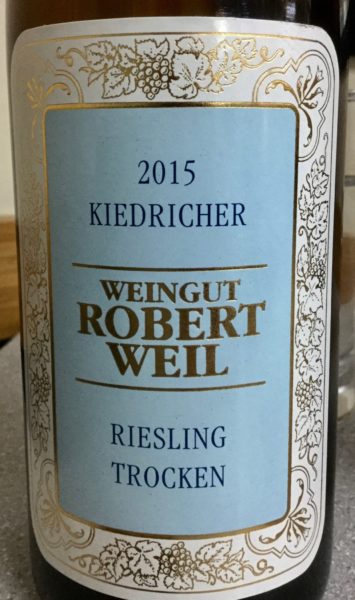
#1
2015 Kiedricher Riesling Trocken
12.5 ABV on #1 8 g/l acid, slate pronounced, 7.6 RS.
Lime, minerality, apple, mouth-watering acidity, salinity and a hint of stone fruit.
Kiedrich Klosterberg – Klosterberg can be translated as ‘monastery hill’. And pays tribute to the nearby monastery Kloster Eberbach. This site sits on stony, gravelly slate and gneiss dominant soil. Produces full-bodied wines.
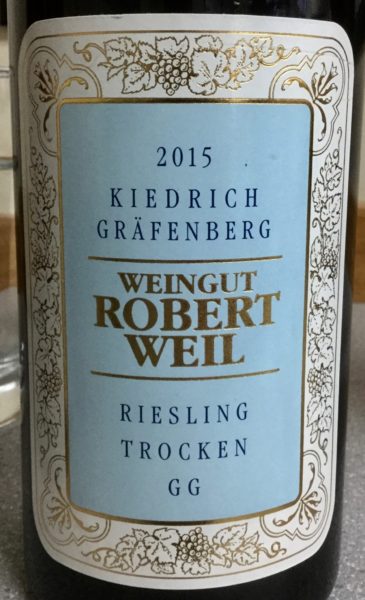
#2
2015 Kiedrich Gräfenberg Riesling Trocken GG
A little more colour intensity than #1, ripe apricot, citrus, background notes of diesel, and lingering red apple on the finish. Definitely a step up in terms of quality. Fermented in large (2400 litre) neutral oak barrels (dry wines) Sweeter wines only in stainless steel.

#3
2015 Rheingau Riesling Kabinett
9.5% ABV lime and minerality dominate, followed by green apple notes. Crisp and refreshing with a medium-plus finish. Very surprised to discover that the wine has 44 g/l of RS to balance the 9.2 g/l of acid.
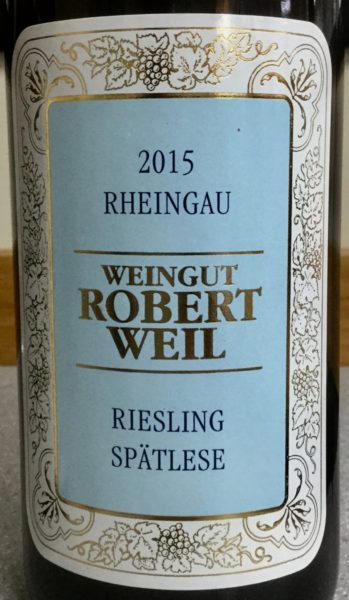 #4
#4
2015 Rheingau Riesling Spätlese
No botrytis, 9% ABV
Late harvest – 7 to 10 days after regular picking.
Golden yellow with medium intensity. Dried stone fruit, apple and less citrus notes
Round in the mouth, good structure, a medium plus finish. 55g/l RS
All wines showed minor, but noticeable colour differences.
Nicolas explained that he recommends double decanting the drier wines, as there is less micro oxygenation in large format barrels.
He also related the story of how botrytis grapes were first used to make sweeter wines. According to Schloss Johannisberg history, in 1775 a courier set off on horseback to get permission from the prince abbot of Fulda for permission to begin the harvest. For whatever reason, he was delayed and by the time he got back, many of the grapes were covered in the gray ‘noble rot’. The cellar master had no choice but to use them and hope for the best. The resulting wine was delicious and unlike any other. This was reportedly, the origin of Spatlese or ‘late harvest’ wine.
Weingut Robert Weil wines are easily recognizable due to their distinctive blue labels. The capsules feature the VDP logo of a stylized eagle with a cluster of grapes and a gold strip below that shows the wines classification.

